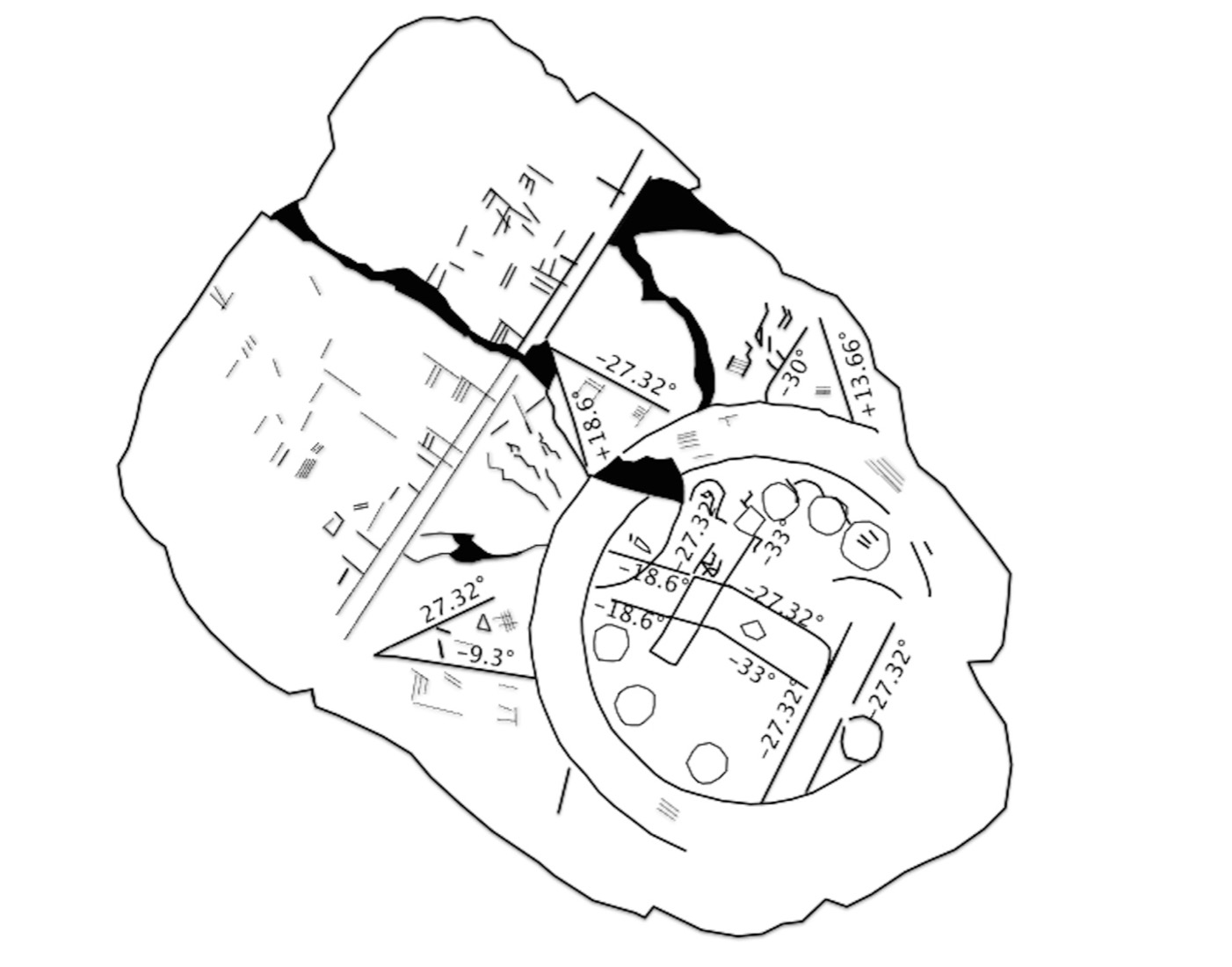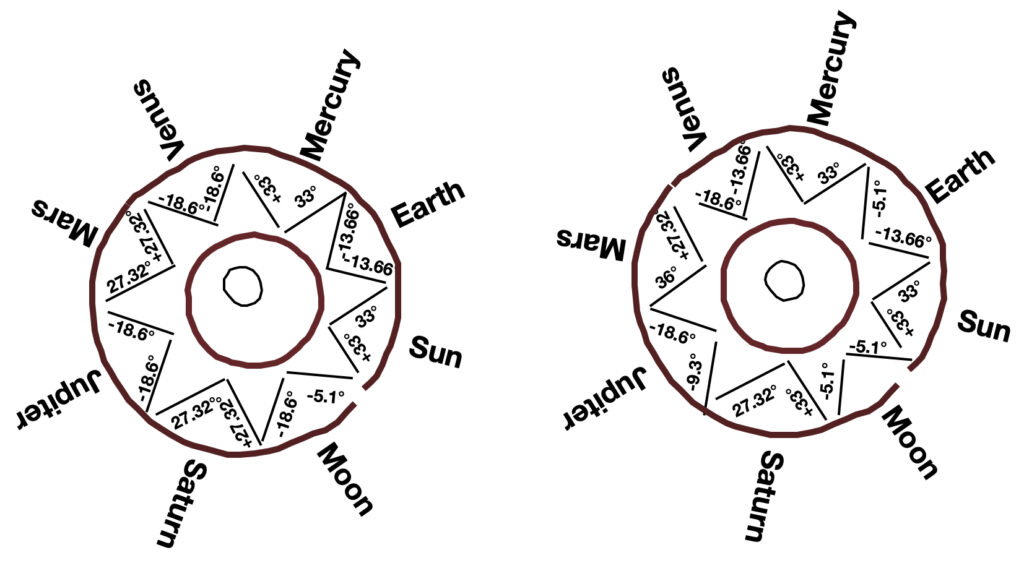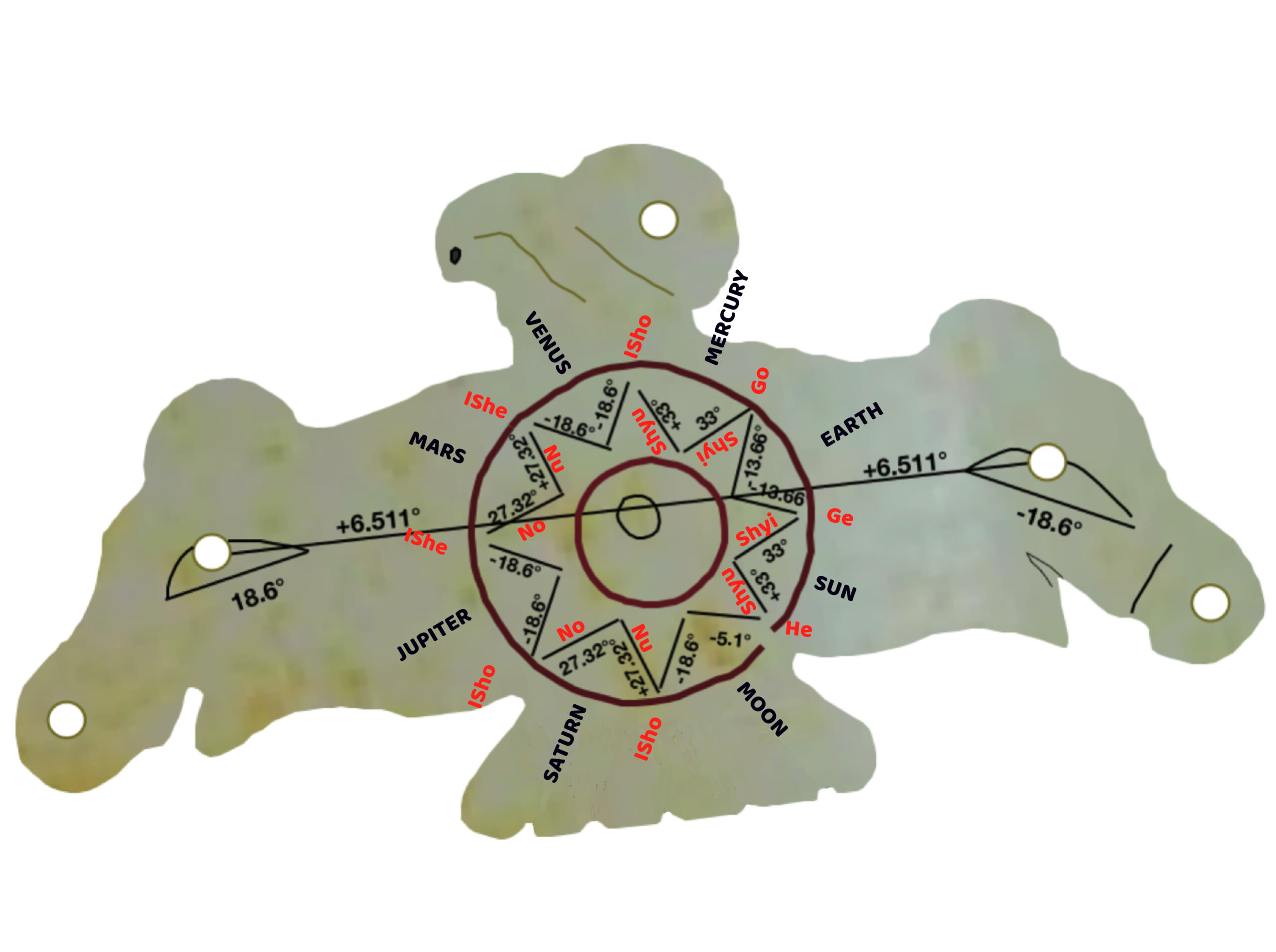Abstract – In this article the angles present in the remnants of a eight pointed star are recorded that is found on the Babylonian World Map, and these angles are compared with the angles present on an eight pointed star that is found on a neolithic Jade Eagle that was uncovered at the Lingjiatan archaeological site in China. Though the two items reveal some similarities in the angles of the lines, with the two patterns being consistent with the Babel Text, the observed angles in each line-pari are not identical. This means the hypothesis that the eight “triangles” (the eight line-pairs bounded on the inner side by a circle) that found on the front side of the Jade Eagle are the names of the planets is still unconfirmed, and further work is required to determine if there any of the surviving sunburst symbols contain identical angular data.
Author Derek Cunningham
Introduction
Through more than 10 years of careful research, the structure of the Babel Text is now reasonably proven1,2. In a recent statistical study, it was shown that the chance for the lines to be random and it is only through luck that they align to these specific astronomical values, and the angles also show four-fold symmetry (with the lines aligned to the left and right of vertical, and to above and below the horizontal axes) and in the study of the Jade Eagle the same angles are found on the reverse side of the Jade Eagle, is in the order of 1 time in 8.5 x 1091 tries.
This is well beyond the six sigma certainty, this being the degree of certainty required to determine if a result is proven in High Energy Physics Experiments; and in statistics, it is equivalent to tossing a coin 20 times in the air, with the intent being that the coin will always land on its side, every single time time, and you can do this feat the first time you try3,4.
The fact is, the same angles are found on ancient geometric images. The only question now remaining is one that relates to language. Do these lines create an alphabet.
Because there exists four-fold-symmetry, where the lines are aligned to the left and right of vertical, and to above and below the horizontal, it is possible that the four directions might relate to the sound of a vowel, and the angle of the lines could represent a consonant. This would then give these geometric patterns an astronomical, almost mystic, meaning, as well as giving the lines a phonetic component, which could then be used by a scribe to perhaps write a prayer, or in the case of the Lingjiatan Jade Eagle, to write the names of the planets3,4.
With the same text being found worldwide (in Africa, Europe, Asia, Australia and North and South America, the geometric text appears to be the fabled One Speech and One Language that is mentioned in Genesis. Thus, the reason for this study is to see if just perhaps the oldest starburst symbols with eight triangles are narrating the names of the parents, and the names of the sun and the moon. The eigth triangle is uncertain, ut could be the Earth, The Milky Way, or perhaps the stars (the heavens).
To test this idea it was thus decided to compare the Lingjiatan Jade Eagle with the relatively famous Babylonian World Map, which contains a block of text that describes various regions around the world, and three surviving triangles drawn outside two concentric circles. The Jade Pendant from China, shows an eight-pointed star symbol where the eight “triangles” are bound between the two concentric circles.


As can be seen, the angles drawn by the Babylonian World Map are consistent with the Sidereal Month, and the 18.6 year lunar cycle, and thus consistent with the Babel Text. There are also lines at circa 5 degrees, which could represent either the number of visible planets from Earth, or it might represent the angle of the moon’s orbit around Earth, which is 5.1 degrees. In some of the more accurate representations of the Babel Texts, the line appears to be drawn to 5.1 degrees.
Unfortunately, though the two sides of the Jade Eagle do show substantial overlap, with 10 out of 16 of the lines being identical in both their drawn angle and their relative “locations”, only two of the six lines drawn by the Babylonian world map (the 27.32/9.3 line pair, can be argued to be identical to the Jade Eagle in terms of angle but not in order. An image of the Jade Eagle with the proposed names for the planets is shown below, with the names read anti clockwise, with Saturn read as NoNu, and Mars as NuNo. In the Babylonian world map the 27.32/9.3 line pair would need to be read clockwise to match the Jade Eagle.

Though a partial match with 2 out of 6 lines is a relatively high percentage, it does not give us enough data to argue the Babylonian world map was designed to describe the structure of the night sky. Here the problem is there are insufficient triangles present, to know if the observed differences and partial overlaps seen in the Babylonian World Map sunburst are related to the Jade Eagle Pattern and whether the visible differences in angles are related to the differences in behaviour that can be seen between the inner planets and the outer planets, in how they appear to follow the sun from our vantage point on Earth.
In the Jade Eagle, which dates to around the same time as Stonehenge, the differences in angle do seem to be linked to this difference between the inner and outer planets4.
Thus, the result is somewhat disappointing and it will be necessary to wait for other examples to be published, so that the meaning behind the 9.3/27.32 line-pair, and a 18.6/27.32 line-pair in the Babylonian sunburst can be fully determined.
References
- Derek Cunningham, A Reanalysis Of The Angles Present Within The Babel Text: Does An Increase In The Size Of The Error Bars Change The Analysis? Babel Texts Research Letters, March 17, 2024.
- Derek Cunningham, New Study Reveals Stone Age People Could Read – and were Homo sapiens the first species to learn to write?, Babel Texts Research Letters, February 25, 2024.
- Derek Cunningham, The Map That Talked, CreateSpace Independent Publishing Platform (first published Nov 2012 as Khyung, The Stone Age Astronaut), Amazon.com
- The 5,000 Year Old Chinese Astronomical Text: A Statistical Analysis of the Reverse side of the Lingjiatan Jade Eagle, Babel Texts Research Letters, March 29, 2024.
- Derek Cunningham, The Babel Texts, CreateSpace Independent Publishing, 2018, Amazon.com
- Derek Cunningham, Stonehenge And The Orbits Of The Planets. Do The Ancient Wood Posts Surrounding Stonehenge Mark The Planets Orbits?, Babel Texts Research Letters, Feb. 25, 2024.
- Derek Cunningham A new look at the Babel Text on the Lingjiatan Jade Eagle Part I: Is this the Earliest Written Names of the Planets, Babel Text Research Letters, March 9, 2024.



